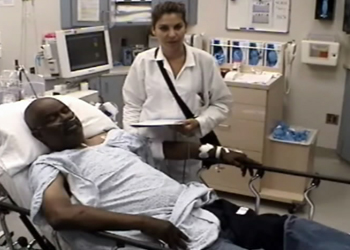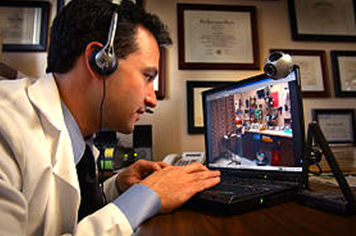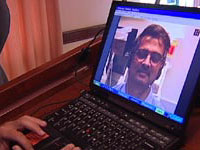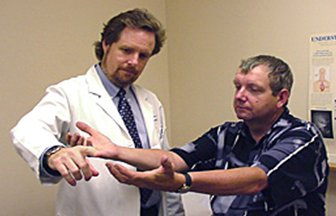Telemedicine Leads to Better Stroke Treatment Decisions
Technology Enables Doctors to Make Correct Decisions for Stroke Patients at Remote Sites
|
San Diego, CA, August 2, 2008 -- Researchers at the University of California, San Diego Medical Center say that their first-of-its-kind study of a telemedicine program which transports stroke specialists via computer desktop or even laptop to the patient's bedside, using highly sophisticated video, audio and Internet technology developed largely at Calit2, could have an immediate and profound impact on the treatment of stroke patients throughout the world.
Brett C. Meyer, M.D., principal investigator of the STRokE
The results of 222 patient cases showed that telemedicine evaluation led to better decision-making than telephone consultations in the care of those patients. The study, funded by the National Institutes of Health, will be published online August 2 in Lancet Neurology, ahead of print.
|
"We assumed that telemedicine was a good idea, but it hadn't been scientifically tested until now," said Meyer, who is also associate professor of neurosciences at the UCSD School of Medicine. "Using STRokE
UC San Diego stroke team doctors can access the telemedicine system - pioneered at UCSD in collaboration with the California Institute for Telecommunications and Information Technology (Calit2), Qualcomm and BF-Technologies, Inc. - from any location with an Internet connection, enabling them to rapidly connect with an emergency medicine practitioner, the patient and perhaps their family members at the "spoke." A mobile camera server with an intravenous-pole design is placed at the foot of the patient's bed at the remote site.
|
"When a person suffers a stroke, time is of the essence," Meyer explained, as treatment to reduce brain infarctions, known as rtPA (alteplase), must be administered within three hours of the onset of a stroke. Waiting too long to give the drug can result in bleeding in the brain, or even death.
"If you make a poor decision using a telephone consultation, you potentially put the patient at risk for a poor outcome," Meyer said. "The question we set out to ask with this five-year study was, 'did we make the right decision?' The answer was overwhelmingly, yes."
Meyer added that this proof that telemedicine results in better treatment decisions than telephone consultations could lead to some immediate changes in how stroke patients in remote areas are evaluated and treated.
|
The reliability of telemedicine had already been established, as reported in the journal Neurology in 2005, where the UC San Diego team studied Internet-based remote video evaluations of acute stroke patients.
In the current study, the researchers had initially planned a four-year, 400-patient study. However, the study's steering committee halted the trial after an analysis clearly showed that one group was superior to the other based on preliminary data of 222 patients. After final analysis the telemedicine group was noted to be far superior for correct decision- making. When adjusted for initial stroke severity, there was no difference in the number of cases resulting in brain hemorrhage, death, or long- term outcomes between the telemedicine or telephone groups.
|
The study was supported by the National Institute of Neurological Disorders and Stroke, Calit2, and the Department of Veterans Affairs, Research Division.
Related Links
UCSD Medical Center
UCSD School of Medicine
UCSD Stroke Center
National Institute of Neurological Disorders and Stroke
2005 Publication in Neurology on Prospective Reliability of STRokE DOC
Media Contacts
Debra Kain, 619-543-6163, ddkain@ucsd.edu
Jackie Carr, 619-543-6163, jcarr@ucsd.edu
Doug Ramsey/Calit2, 858-822-5825, dramsey@ucsd.edu




